The barbarian invasions destroyed classical civilization in the period 350-700 A.D. The period included the fall of Rome in A.D. 476 and through the 500 or so years that followed , the Dark Ages became the early Middle Ages. The Dark Ages are characterized by a series of invasions, each more destructive than the one before. Western European cities were destroyed and violent and criminal behavior affected almost everyone. Valuable art was stolen and Rome, which at one time had a population of over one million, had a population of les than 50,000 by the end of the fifth century. During the period of these invasions, learning and education were not considered important, and people could not and would not travel because of fear. Trade nearly stopped. Sea travel was especially dangerous because pirates sailed freely in search of treasure and plunder. It was not uncommon for towns to completely disappear after an attack.
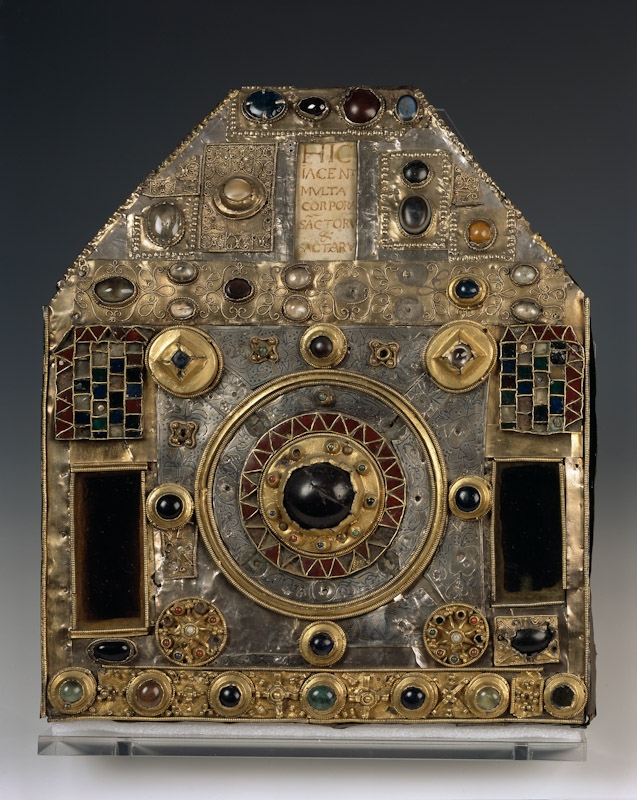
''With over two thousand archaeological treasures from museums all over the world, exhibition curator Jean-Jacques Aillagon explains how the Roman culture and Barbarian identities influenced each other during the first millennium of our era, and gave rise to historic a new civilization. The birth of the empire, its defence and decline, the Roman-Barbarian kingdoms of Vandals, Ostrogoths, ...''
”Poetry must have something in it that is barbaric, vast and wild. ….Genius is present in every age, but the men carrying it within them remain benumbed unless extraordinary events occur to heat up and melt the mass so that it flows forth….When shall we see poets born? After a time of disasters and great misfortunes, when harrowed nations begin to breathe again. And then, shaken by the terror of such spectacles, imaginations will paint things entirely strange to those who have not witnessed them. ( Diderot )…. That might be difficult to substantiate with regard to the barbarian invasions; though the common stereotype may be far less valid than some educated minds would have us believe.
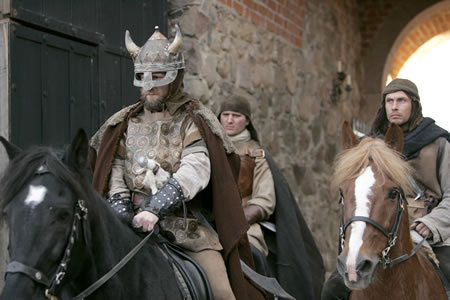
mud-brick.com ''Images of invaders like this one from The History Channel’s special “The Dark Ages” dominate popular understanding of this time period.''
Most of us have a certain general notion of what would constitute a ”barbarian invasion” ; namely wild hordes of almost naked blond-haired, blue eyed Germanic warriors emerging like the Indians of North America from the swamps and forests of central Europe and charging with savage war hoops upon Roman armies corrupted and debilitated by an overrefined civilization. We see them smashing through the crumbling defenses of a doomed empire, ravaging and burning the flourishing cities of Gaul, Italy, and Spain, and ultimately bringing on the so-called Dark Ages in which the light of culture flickered and sputtered dimly in a few scattered monasteries.

mud-brick.com ''Finds like the Sutton Hoo helmet depicting warriors with spears and swords indicate that violence and conflict were a real part of Dark Age life.''
Slowly, then, the softening influence of Christianity supposedly converted these primitives to the milder habits of civilization, and out of the vigor they infused into a moribund society arose the states and culture that we call medieval. It is a grand and rather satisfying panorama; it fits neatly into our preconceptions about sin, punishment, fall, grace, and redemption. But it is likely to be largely false, and many of the elements in this picture have been, and should be thrown into question.
Many tribes and peoples did move into the territory of the Roman Empire between the fourth and sixth centuries. Their numbers were relatively small. The Vandals, for example, counted no more than eighty thousand males before they crossed the Straight of Gibralter to Africa, and probably less than half of these were fighting men. Nevertheless, many of these peoples succeeded in establishing political units within the empire, until the empire itself splintered.
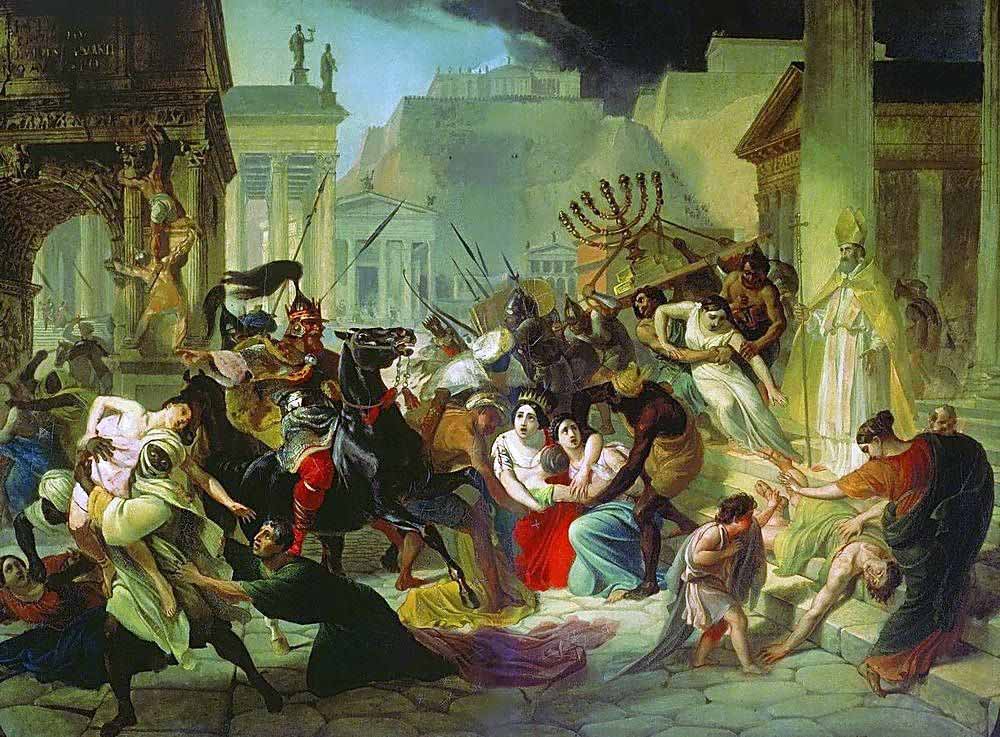
Karl Briullov. "The sack of 455 is generally seen by historians as being more thorough than the Visigothic sack of 410, because the Vandals plundered Rome for fourteen days whereas the Visigoths spent only three days in the city"
”The term “Dark Ages” as it is currently used derives from the assumption that the lack of written documents during the period signals a time of intellectual darkness. In turn, lifeways during the Dark Ages are thought to be rather basic and simplistic. For archaeology, such ideas encouraged assumptions that sites during this time period would not exist, because their quality would have been so poor that they could not survive in the archaeological record. Recently, archaeologists have realized that such ideas reflect modern Western ideas of progress, rather than reality.”
However, archaeology allows us to balance these po
r images of savage confrontation with evidence of cultural complexity and innovation. The Goths that invaded Rome were no dirtier, sweatier, or smellier than many of the empire’s Roman inhabitants. Populations undoubtedly suffered chaos and terror through violent interactions and disease, but families also continued to farm, bartered for special goods, enjoyed games, and even smiled under sunny skies.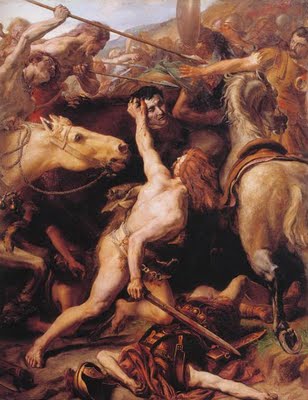
Joseph-Noel Sylvestre. ''Some of the best of this kind of paintings were from the French painter Joseph-Noël Sylvestre (1847-1926). It’s clear that he is totally with the barbarians, who are cutting the Romans to pieces.''
”In his 1936 book, Mohammed et Charlemagne, Belgian historian Henri Pirenne argued in great detail that the Dark Ages of Europe began rather suddenly in the middle of the seventh century; and that this sudden and catastrophic decline in civilization was due to Islam’s blockade of the Mediterranean. Up to that time, Pirenne showed, there was no evidence of a decline in Classical culture. True, the Western Roman Empire as a political entity had disappeared in 476, but the literate, prosperous and urban civilization which we call “Classical” continued virtually uninterrupted. The Goths and other “Barbarian” peoples who ruled the provinces of the West after 467 did not try to destroy Roman civilization and civil society. Indeed, as Pirenne showed in great detail, they did everything in their power to preserve it. They adopted the Latin language, accepted Imperial titles from the Emperor in Constantinople, and minted gold coins with the image of the Eastern Emperor emblazoned upon them.”
The Huns came out of he vast central plains of Asia and advanced almost to Paris, as well as deep into Italy. Angles, Saxons, and Jutes crossed the North Sea from Denmark and northwestern Germany to take possession of England. The franks made their way over the Rhine into northern Gaul and created the nation that still bears their name. The Burgundians seized the territory around Geneva and subsequently advanced as far as Lyon. Vandals and Suevians likewise breached the barrier of the Rhine and moved across present-day France into Spain.
There the Suevians stayed, disappearing into the population, while the Vandals crossed to North Africa. Ostrogoths and Visigoths marched from Scandinavia to the extremities of Italy in the course of three centuries, and the Visigoths continued on into Spain. Alans traveled from the highlands of Persia to the Straight of Gibraltar. Lombards crossed Germany into what is now Hungary and then moved into what is now Hungary and then moved into the part of Italy that is known as Lombardy to this day.
With a few exceptions, the barbarians were Germans; that is they spoke a Germanic language or dialect, though they themselves seem to have been unconscious of their linguistic if not racial unity; they had no common word for themselves. The old German form of the word ”deutsch” meaning ”of the people” did not really come into general use until the eighth century, when it was introduced into Germany by Anglo-Saxon missionaries.
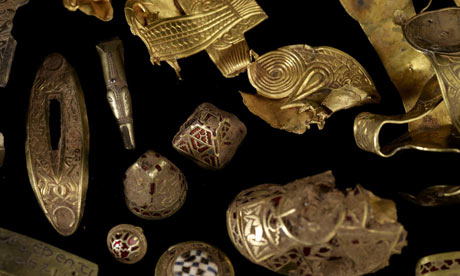
Guardian : ''The cache he discovered has been compared in significance to the Book of Kells and the Lindisfarne Gospels. It is of such proportions that it at once confirms what academics had suspected about the might of the most successful Anglo-Saxon regime and yet also throws these assumptions into a completely new context. How could the Mercians possibly have had so much wealth? The yawning gap between the rich and poor exposed by the find has set historians reeling. An era that used to be called "the dark ages" was obviously a lot darker for some than for others.''
The first century Roman historian Tacitus draws a picture of a ”distinct unmixed race” of men with ”fierce blue eyes, light hair, and huge frames fit only for sudden exertion”. These men did in fact have a kind of war whoop, although there was an excellent rationale for it. The Germans, Tacitus says, roused their courage in war by singing heroic songs. As superstitious as the Romans, they regarded the note they struck in song as an augury of the outcome of battle.
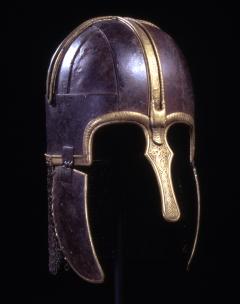
''...next to the place that the wonderful York Helmet was found during the Coppergate excavations. The helmet has been dated to about 750 to 775. Evidence of a settlement from around 700 to 850 was discovered not far away at Fishergate ''
Tacitus pictures a people but recently entered into the Iron Age. Few had swords or long lances. Their principal weapon was a spear with a short, narrow head, using little iron, which could either be thrown or used at close quarters. They wore no armor in battle, and only a few had metal or even leather helmets. Their brilliantly painted shields alone served them for defense. For the most part, the Germans obtained their weapons from the Romans, by way of trade or booty; archaeological finds throughout Germany, Denmark, and the Baltic countries testify to the vast quantities of Roman arms imported by the barbarians.
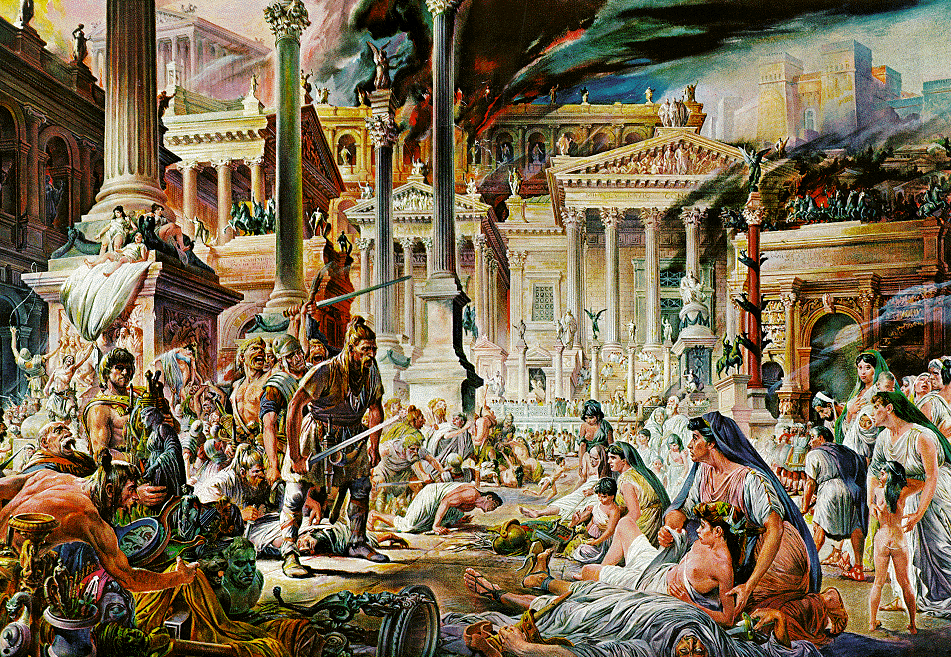
Michael Rosenblum: ''The barbarians, it turns out, were inside the Empire all the time. The Romans, in a word, did it to themselves, and almost willingly. In shorthand, that is true, but the nagging question is always, how does it happen? How does it happen that the Roman Empire, a successful, commercial, secular, productive, highly functioning society becomes the Europe of the Dark Ages? The Roman world is a place most of us would have felt extremely comfortable in. The Dark Ages, not so.''
“Barbaric people have more vigour than civilized people …Everywhere vigour and poetry decline as the philosophic spirit has made progress…(The latter) wants more strict, exact and rigorous comparisons: its cautious progress is the enemy of the fluent and the figurative…With reason there is introduced an exactness, precision, method, and, if you will excuse the word, a kind of pedantry with kills everything”….“Certainly there are still barbarians. When won’t there be? But the time of barbarism is past. The century has become enlightened. Reason has grown refined, and the nation’s books are filled with its precepts. The books that inspire benevolence in men are practically the only ones read.” ( Denis Diderot )



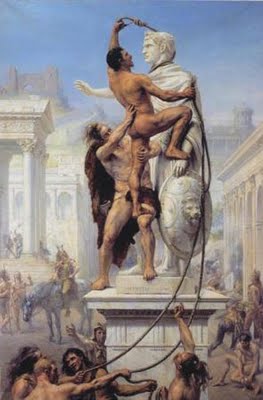




 COMMENTS
COMMENTS
Good article! The photo of “barbarians” from the History Channel made me laugh though. If these are supposed to be Vikings, the horned helmet thing has no basis in historical fact. Then again, the H.C. does this a lot: a show about Medieval England in which we see what life was like back then via film footage from Victorian London; a show depictingTsar Peter the Great writing a letter with a 19th century kerosene lamp on his desk; a show about the Salem witch trials in which we see doors with modern hardware on them and people wearing modern glasses; a show set in the 18th century with electrical cords trailing down from “candle lamps”….a show…oh, you get it.